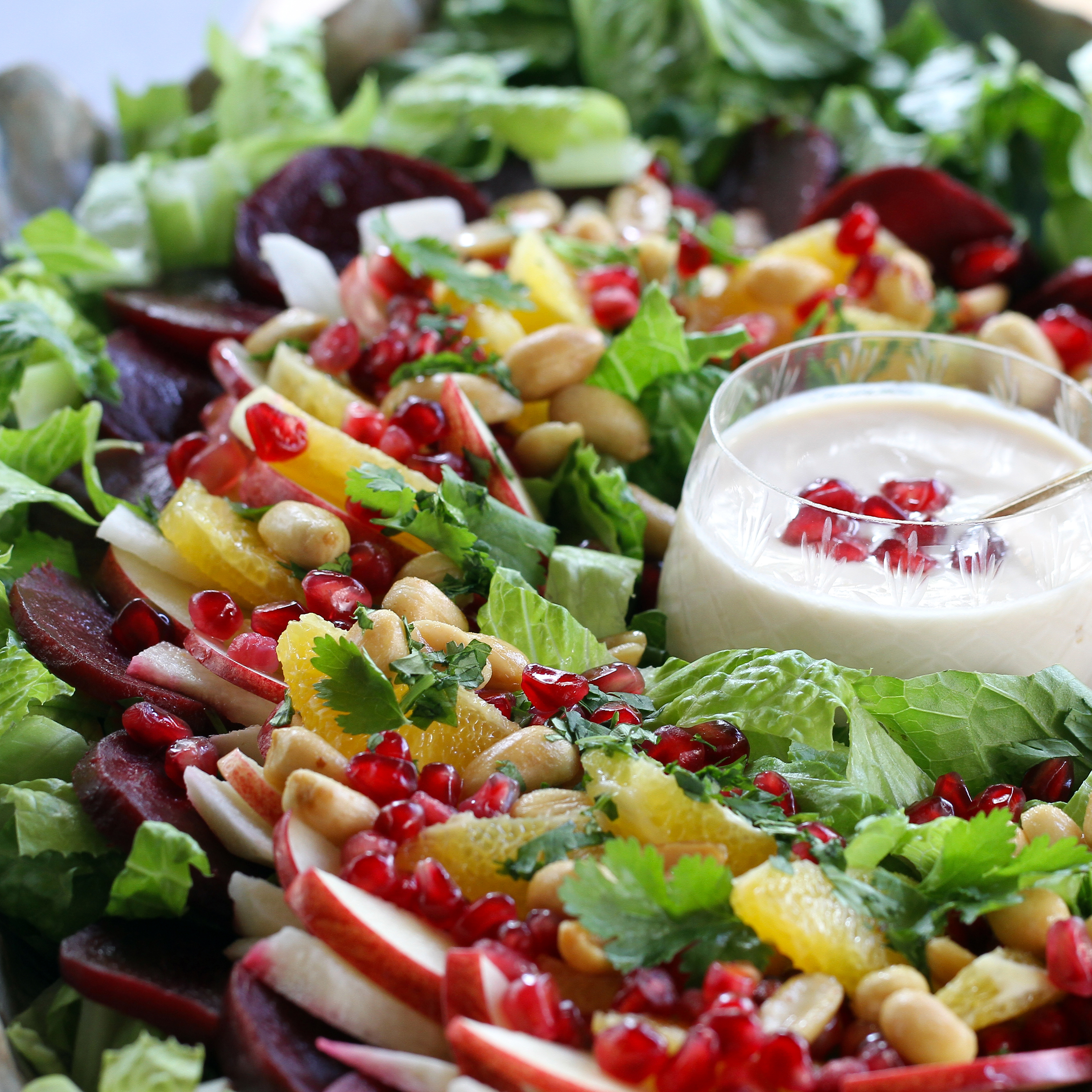Christmas Eve Salad
 In most Mexican families, Christmas is celebrated on December 24th. Presents are opened at the stroke of midnight of the 25th after a day full of tamales and champurrado. Families pray and admire elaborate nativity scenes that have taken generations in collecting prized religious pieces and relics. The smell of planta gobernadora or creosote bush line the nativity scenes and release a distinct musty but pleasant aroma. The smell of Christmas.
Part of the festivities leading up to Christmas Eve are nine days of posadas. Beginning on December 16th, these novenas as they are called, represent each month of Mary’s pregnancy with Jesus.
Nine different homes host a posada every day, praying the rosary, re-enacting through song Mary and Joseph asking in-keepers for lodging. When they are finally recognized and allowed in the home, everyone gathers to pray, enjoy a feast, celebrate and sing villancicos (carols). Children break a piñata with a clay pot inside, full of fruit and candy and are given a bolo (goody bag) full of peanuts, oranges and colorful candies filled with peanuts or orange peel called colación. These pretty little candies are also given as a reward to those who kiss or “adore” baby Jesus once he’s been placed in the Nativity scene.
Ensalada de Noche Buena, or Christmas Eve Salad plays an intricate part of this traditional feast. Named after the Poinsettia (Noche Buena), which also means Christmas Eve in Spanish, it resembles the beauty and colorful plant that we are so fond of every holiday season. Arranged in a circle, similar to a flower and accented by bright crimson pomegranate arils, like jewels on a wreath, this delicious salad is sweet, savory and crunchy for all to enjoy.
Recipe developed for Nestle Kitchens.
Photo by Nestle Kitchens
Print
In most Mexican families, Christmas is celebrated on December 24th. Presents are opened at the stroke of midnight of the 25th after a day full of tamales and champurrado. Families pray and admire elaborate nativity scenes that have taken generations in collecting prized religious pieces and relics. The smell of planta gobernadora or creosote bush line the nativity scenes and release a distinct musty but pleasant aroma. The smell of Christmas.
Part of the festivities leading up to Christmas Eve are nine days of posadas. Beginning on December 16th, these novenas as they are called, represent each month of Mary’s pregnancy with Jesus.
Nine different homes host a posada every day, praying the rosary, re-enacting through song Mary and Joseph asking in-keepers for lodging. When they are finally recognized and allowed in the home, everyone gathers to pray, enjoy a feast, celebrate and sing villancicos (carols). Children break a piñata with a clay pot inside, full of fruit and candy and are given a bolo (goody bag) full of peanuts, oranges and colorful candies filled with peanuts or orange peel called colación. These pretty little candies are also given as a reward to those who kiss or “adore” baby Jesus once he’s been placed in the Nativity scene.
Ensalada de Noche Buena, or Christmas Eve Salad plays an intricate part of this traditional feast. Named after the Poinsettia (Noche Buena), which also means Christmas Eve in Spanish, it resembles the beauty and colorful plant that we are so fond of every holiday season. Arranged in a circle, similar to a flower and accented by bright crimson pomegranate arils, like jewels on a wreath, this delicious salad is sweet, savory and crunchy for all to enjoy.
Recipe developed for Nestle Kitchens.
Photo by Nestle Kitchens
Print
Christmas Eve Salad
- Yield: 10 1x
Ingredients
Scale
For Sweet Cream Dressing
- 1 cup NESTLÉ® Media Crema
- 3 tablespoons fresh orange or lime juice
- 2 tablespoons granulated sugar, or to taste
Salad Ingredients
- 1 head Romaine lettuce, leaves washed and shredded
- 4 medium beets, cooked, peeled and thinly sliced (about 4 cups)
- ½ large jicama, peeled and cut in 1/4-inch-thick slices
- 2 red apples, thinly sliced
- 3 oranges, peeled and cut in wedges, or 3 cups mandarin orange segments
- ¾ cup pomegranate seeds
- ½ cup roasted peanuts
- 1 tablespoon finely chopped fresh cilantro
Instructions
- Instructions:
For Sweet Cream Dressing
- Combine media crema, orange juice and sugar in small bowl; stir well to combine.
For Salad
- Arrange shredded lettuce leaves over large serving platter or on bottom of a large salad bowl.
- Top with beets, jicama, apples and orange wedges. Sprinkle with pomegranate seeds, peanuts and cilantro.
- Serve with sweet cream dressing.
Notes
Apple and jicama slices can be brushed or lightly coated with orange juice to keep from browning.


